The Nice
Albums reviewed on this page: The
Thoughts of Emerlist Davjack, Ars Longa Vita
Brevis, Nice, Five Bridges,
Every Which Way, Elegy, Refugee
Emerson, Lake and Palmer, Tarkus,
Pictures at an Exhibition, Trilogy,
Brain Salad Surgery, Works, Vol.
1,
Works Vol. 2, Love Beach.
I've decided to use this space to write about progressive rock in
general, in addition to the Nice, for two main reasons. First
of all, nobody reads this site so I can do as I please. Second
of all, the Nice are early touchstones for the movement (if one can
call it that) and I want to state how I view what went on. So,
it's 1967 and everybody is mixing every kind of music, with rock,
orchestras, jazz, African rhythms, opera, and generally there is a
lot of experimentation. Of course, this didn't last very long
(look at the Rolling Stones) and people returned to previous, clearer
formulas for music. But there were still plenty of groups that
continued on mixing jazz and/or classical music with rock. Here
is one fairly broad definition for "progressive" rock,
then: groups that incorporated classical influences into their
music. Some examples? Whatever group Keith Emerson
happens to be in (the Nice or ELP) as he endlessly borrowed from
composers, Yes with their classical guitar pieces, a synthesized
Brahms movement and an interpretation of the Rite of Spring, or King
Crimson whose lack of a real blues base allowed all sorts of things
to happen. Of course, calling it "progressive" seems
inapposite - I think it should be called "regressive"
because it takes from the past. Anyways, here is another
broadly applying term: "art-rock", which I never really
used because I was not sure what it really meant. Then I
discovered no one else did either. I think it refers to groups
that either combine jazz with rock (like Soft Machine) or straddle
the fence, adapting structures and things like that from classical
music, without the real motifs (or technical prowess). "Prog
rock" was more of an actual movement, as ELP and Yes got
exceedingly self-indulgent (and popular) as time wore on. Pink
Floyd? More art-rock than prog, but heck these are just terms
used to help us understand what the music is. I hope that
helped some, but most likely not.
The Nice are probably one of the more important progressive rock
bands that most people do not know about, despite the fact that their
final three albums all made the UK Top Ten. Much as I like to
think that 70s self-indulgent prog rock didn't spring from the head
of Zeus, the Nice are the exception that proves the rule. The
main perpetrator: Keith Emerson, later of Emerson, Lake and Palmer.
Almost from the beginning it was clear that Emerson limited himself,
and that the other members of the Nice were essentially his backup
band. The departure of guitarist Davy O'List during the
recording of the Nice's second album deprived the group of the only
other competing lead instrument. From there, it was a long deep
dive into Emerson's classical pastiches. But that is not the
worst of it - let us not forget Lee Jackson, "singer" and
guitarist. Despite claims that he is the worst vocalist ever (a
spot I have reserved for Dave Matthews), his performance on the first
two albums is just shy of terrible. But he became progressively
worse, and his lyrics are not the greatest either, helping foster the
Nice's habit of long instrumentals.
For all of their negative aspects, the Nice was not a bad band.
Emerson's playing is a lot more tasteful than it was in his later
days, and he had yet to discover synthesizers. Historically,
the Nicer were the first group to really use classical music as a
major influence, with Procol Harum a close second. Nobody else
was doing rock renditions of classical works in 1967 for pete's
sake. Plus, despite whatever grievances I may have against him,
Emerson's organ playing was highly unique and downright experimental
for the time. I am not sure what he did to his organ, but it
was not pretty. So, listening to the Nice is essentially a
tradeoff between Lee Jackson's awfulness and Emerson's overblown
style, and Emerson's inspired playing and
not-quite-as-large-as-it-would-get musical ego. A tradeoff that
quickly turned negative. Confusing? Contradictory?
Yes, but true, which is probably why I was able to purchase all of
their albums on vinyl for a total of 10 bucks from EBay.
Eventually, Emerson dominated the two remaining members on their
final albums and the group broke up. Jackson formed his own
group which promptly sank into the mire (correctly), and Brian
Davison disappeared off the face of the planet (session work, which
is too bad since he's a decent drummer).
P.S. Here's a few brain teaser what ifs - The group invited Robert
Fripp to join them after O'List left. Can you imagine Fripp and
Emerson combined? Wowsa. The other one - Emerson had
planned to do a "project" or something with future BTO
guitarist Randy Bachman after the Nice ended. Thank God ELP
formed instead. That would have been really scary.
Personnel: Brian Davison (drums), Keith Emerson (organ,
piano, harpsichord, etc.), Lee Jackson (bass, vocals), Davy
O'List (guitar). O'List left during the recording of Ars Longa Vita
Brevis.
 The
Nice: The Thoughts of Emerlist Davjack (1967), ***
The
Nice: The Thoughts of Emerlist Davjack (1967), ***
Wow -
classical psychedelia. This is the usual 1967 psych rock (and I
mean rock), but Emerson places classical quotes in every song.
Forget ELP's later over-seriousness and self-indulgence - the Nice
was a pop/rock group overall and Emerson is kept in check by the rest
of the band. I mean, could "Flower King of Flies" be
any more lightweight and silly? The title alone should answer.
OK, "Dawn" is ruined (except for camp value) by Jackson's
serious whispered delivery of utterly ridiculous lyrics, and I have
no idea what "Tantalizing Maggie" is about, except for his
bad voice. Aside from these, Thought of Emerlist Davjack has
two good pop songs --"The Cry of Eugene" which is one of
the best things they ever did, and the title track. The first
has Jackson's best vocal performance on the record, and O'List sings
the second: coincidence?. The album also has two instrumentals:
"Rondo", which despite its eight+ minute length keeps my
attention, and "War and Peace", with Emerson making his
organ do things that nobody had done before (or perhaps since).
I mean, is that organ feedback? Weird. O'List is around
in an ill-defined manner, abusing his guitar occasionally. So,
musically it rates a **1/2, but I have to give them something for
self-production, Emerson's experimentation and being the first to try
an adapt classical works for a rock group. Less Lee Jackson's
contributions: bad lyrics and one god-awful voice.
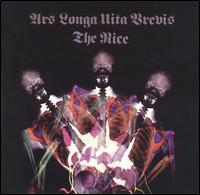 The
Nice: Ars Longa Vita Brevis (1968), **1/2
The
Nice: Ars Longa Vita Brevis (1968), **1/2
I once read a
review that was very enthusiastic that the title track which is a
side long piece was divided into movements. Let me assure you
that it is not that exciting, and O'List jumped ship during the album
sessions. On Ars Longa Vita Brevis the band's different
elements separated themselves out - the psychedelic pop songs loose
their classical quotes, and the instrumentals turn into full-blown
classically-derived works. The album's opener is the most
integrated; a cover of Bernstein/Sondheim's
"America", that has a hilarious intro but
then turns into an Emerson ego exercise, and became a
mid-sized hit in England. The psych-pop songs are
a mixed bag --"Daddy Where Did I Come From" is a
disconjunctive sometimes funny mess, and "Happy Freuds"
sounds like a second-rate Zappa imitation. "Little
Arabella" is the best non-instrumental
song, and would have been a perfect single except for
Emerson's short, pointless solo. The second side, consisting of
the title track, is pretty boring with some unoriginal orchestra
parts, a boring drum solo, and ugly foreshadowing of the future of
Jackson's voice. The exception is the "3rd Movement",
one of Bach's Brandenberg Concertos successfully arranged for band
and orchestra. Even the Nice couldn't screw this one up - the
result is that Emerson doesn't meander that much, and it's their most
satisfying classical cover. Despite the title, the band members have
outlived this album's value as art There are some alternate versions
with O'List, which can be found on Autumn to Spring.
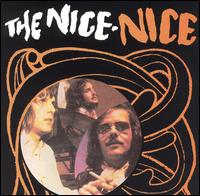 The
Nice: Nice (1969), **
The
Nice: Nice (1969), **
The Nice had
become a one trick pony when they recorded Nice. Their problem
was that Emerson was that pony, and he was running low on ideas.
Nice does not have a lot of musical variation, Jackson has run
out of lyrics, and his voice is downright annoying. Their
approach was to drop the pop songs and focus on a less experimental
sound without abrupt lurches into classical passages. It is an
interesting change, and the band sounds much more mature. The
first side has four rock songs and it is probably best to address
each briefly. "Azrael Revisited" has a nice sound,
bad vocals and a "shoobie do wah" part that annoys me
greatly. "Hang on to a Dream" is a fairly listless
and boring cover of Tim Hardin's classic. The worst song on the
album, "Diary of an Empty Day", is about how Jackson cannot
come up with any lyrics. It is absolutely pathetic - "I
can't think what to say / My mind's a blank today". Thanks
for sharing, and charging me for the pleasure. Finally, "For
Example" shows even Emerson going dry, and only the multiple
tempo/backing changes make it bearable. For the second side of
the album you better like organ. A lot. It has two live
tracks, and is essentially
an extended Emerson organ recital, with Jackson doing
as little as possible while still technically playing bass.
"Rondo(69)" is fairly interesting (thank God it's an
instrumental), but Dylan's "She Belongs to Me" stops,
starts, and goes nowhere. Overall, Nice is fairly
consistent - it is tiresome, and everything is tainted by Jackson's
incompetence or Emerson's overplaying. (More proof the All
Music Guide overrates). Do you think Gary Oldman's costuming
for Dracula was inspired by Jackson's wardrobe? Produced by the
group.
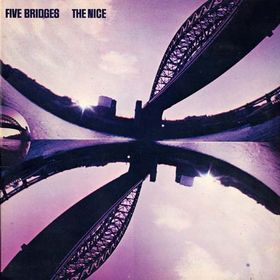 The
Nice: Five Bridges (1970), **
The
Nice: Five Bridges (1970), **
"Five
Bridges" was
an interesting idea with limited success - a five-part suite,
recorded live with a symphony orchestra. Deep
Purple actually beat the Nice to this, but it is not as
if anyone is ripping anyone else off (the Nice were commissioned to
do the piece). Emerson and Joseph Eger wrote a pastiche of late
19th century classical music, focused around two rock songs.
Everything is tolerable right up to when Jackson opens his mouth.
The suite doesn't really work, and its ending is a reprise of the
only real "tune," using a trombone solo to distinguish it
from its previous appearance. The second side is a couple of
classical instrumentals ("Karelia Suite" again), a boring
Dylan cover, and the dreadful studio outtake "One of Those
People". This amount of organ really gets mind numbing
after a while. Nothing new otherwise, and the band's last album
as a group.
 Brian
Davison's Every Which Way (1970), **
Brian
Davison's Every Which Way (1970), **
This
is not the sort of album placed at the top of someone's Want List, or
even on the list at all. I, for one, do not have such a list in
the first place, but a morbid sense of curiosity, plus the simple
knowledge of this album's background led to its purchase when I
stumbled across it. The album is not particularly worth it,
however, which is why it receives my standard rating for well-played
music that is completely unaware of the total
indifference it provokes in the listener. Every Which Way
has a bunch of slow to medium paced grooves, led by Graham Bell's
acoustic guitar and vocals, overlaid with John Hedley's rote
pentatonic guitar riffs or Geoffrey Peach's smooth soprano sax work.
There are few things that I hate like soprano saxophone, and I get
suspicious of sax players who turn jazzy into comatose. This
album is something like a sluggish, long-winded Traffic
with more sax ("All in Time", "The Light", or the
nine+ minutes of "Bed Ain't What It Used to Be"), or a
curious rip-off of King Crimson's "Moonchild",
although they had the sense to curtail the aimless ending ("Castle
Sand"). One track that does stand out is "What You
Like", which may be no better than the others, but has has a
dark dissonant tone, making the band sound a bit like Catapilla.
Another is "Go Placidly", a bona fide good song
because it is brief, to the point, has some energy, a couple of nice
solos from the Designated Soloists, and consequently is the only song
I can remember from the album. Musically, everyone's is fair,
but it would not be much of a stretch to say that Davison is the best
musician among the bunch, which says something.
In fact,
far more interesting than the music are the album's liner
notes, which attempt
to market the album as an anti-supergroup. "There isn't a
hit song on this album" they proclaim, and boy were they right.
Probably the only way to promote the album; I mean, it isn't like
anybody was going to say, "I must have that new album by Brian
Davison's new group!", and the lack of a big name means they
have to promote the music instead, and the group's groupness.
The problem is that the music sucks. I mean Davison and Alan
Cartwright (who later turned up in Procol
Harum)
make a nice rhythm section, but aside from that ...well, there is a
reason these guys were not household names. Davison's
production is not anything special, either; he mixes his drums in a
fairly interesting fashion but lacks ideas beyond that. Watered
down - the musical equivalent of a gray day.
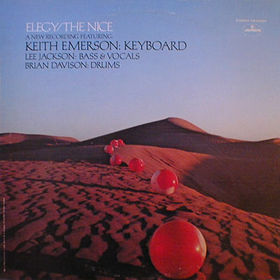 The
Nice: Elegy (1971)
The
Nice: Elegy (1971)
Posthumous
live cuts and outtakes! Yippee! I wish I could say more
about this album, but it is nothing new. Let me do it track by track.
First, a live version of "Hang on to a Dream" which Jackson
does not entirely destroy, but scarcely differs from the
studio version. That is followed by Dylan's "My Back
Pages", which has its moments, but Jackson occasionally sings.
The back side starts off with a studio version of some Tchaikovsky,
nothing new there. It ends with a live recording of "America"
featuring Emerson's long extended organ
explosions/exploitations/feedback ending. Nothing like a
cash-in album to take advantage of someone's newfound success with
ELP.
The Nice: Autumn to Spring (rec.
1967-8, rel. 1973)
Sort
of equivalent to Yesterdays, a collection of tracks with
O'List. "Diamond Hard Blue Apples of the Moon", which
was a b-side, and an alternate version of "Daddy Where Did I
Come From" with O'List are the only tracks that had not
previously appeared on LP.
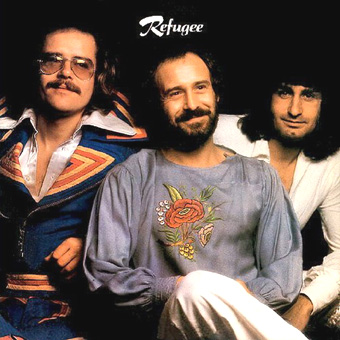 Refugee
(1974), **1/2
Refugee
(1974), **1/2
To
what extent can one man ruin an entire album by himself? You
would probably say that it depends on the number of people in the
group and the ruiner's role. Well, when that person is the lead
singer it is pretty damn hard to ignore them. That's right -
Lee "Aural Disturbance" Jackson is back, trying to make The
Nice Mk II with Davison and featuring Patrick Moraz in the role of
Keith Emerson. (How
hard would it have been to find a guitarist who could sing, freeing
Jackson to play something interesting on his bass?) I'm
not sure whose idea this was, whether Moraz approached them with
dreams of recreating the success of the Nice or if the rhythm section
found a suitable sucker in Moraz, but either way he was the right man
for the job. Remember in the 1980s when Americans were afraid
they were going to lose their jobs because the Japanese did it better
and faster? Well, that's Moraz. Not that he is Japanese
(Swiss, actually) but his musical taste is fantastically similar to
Emerson ("Ritt Mickley" could be an ELP tune, and there are
a pair of suites complete with movements). The big difference
is that Moraz was one of those players who needs a whole smorgasbord
of instruments to work with (a
la Wakeman) and thereby avoids the whole "listen to me ram this
solo down your throat for umpteen minutes" approach, in favor of
making lots of sound. When Moraz does haul out the Hammond
Organ, Refugee sounds astonishingly like the Nice (the fifth movement
of the "Grand Canyon Suite"), for those feeling nostalgic.
Ss for Jackson, I can truly say that one of those devices that
artificially created speech would sound better than his normal
"singing" voice. It has not gotten any better since
the days of the Nice --same annoying mannerisms, same phrase biting,
almost like he nasally grunts his vocals. What are the first
words out of his mouth here? "Some-day you're gonna feel
the pain." Well guess what? I feel the pain now Lee,
right now. The first verse to this song (cleverly titled
"Someday") also begins with these two lines "Someday /
I'll go away." At that point you should turn off your
stereo and walk away yourself, because Jackson has got the whole rest
of the album to sing through. Maybe that is too harsh; after
all, Jackson did hang it up after this one final attempt at creating
mass deafness. If you can overlook his vocals (no ordinary
feat) Moraz does well on the keyboards (try the instrumentals
"Papillon", "Gatecrasher", "Ritt Mickley")
and Davison's drumming is serviceable, as always. You have to
wonder what even an average singer would have done with this
material, as it is
entirely hit-or-miss in its current state.
Produced by the group and John Burns. Moraz soon left to join
Yes.
Keith
Emerson and the Nice: Live 2002 (2003)
That's
right! I guess they've been doing limited gigs in England the
past couple of years. Wanna take bets on how bad Lee Jackson's
vocals are now? Listed only for amusement.
Emerson,
Lake and Palmer
ELP are like a better version of the Nice, but Emerson discovered
synthesizers. Personally, I think that use of synthesizers
should be regulated, and Emerson legally restrained from using them.
While Stevie Wonder, Pete Townshend and even Rick Wakeman would be
fully licensed, any attempt to advocate such a position for Keith
Emerson should result in repeated listening to songs such as "Tank".
Actually, Emerson did branch out with ELP - not only does he seem to
transfixed by classical music, but also infatuated by pre-war
American piano styles as well. Honky-tonk, barrelhouse and
Gershwin all make appearances in one guise or another.
The word that probably comes closest to ELP's sound is tocatta,
which is defined as "a composition in the style of an
improvisation, for the piano, organ, or other keyboard instrument,
intended to exhibit the player's technique." One gets a
whole lot of technique with an ELP album, sometimes too much.
After a while one notices that there's a pattern to the songs on
ELP's albums. There's usually a humorous number, sort of the
Ars Longa Vita Brevis tradition, most notably "The
Sheriff" and "Jeremy Bender". Additionally,
there must be a Greg Lake guitar number, usually with limited input
from E and P - these seem to be their hits "Lucky Man",
"From the Beginning", and "Still... You Turn Me On".
At least once Emerson trots out a riffy, popping organ part while
Lake alternately growls or shouts ("Bitches Crystal",
"Living Sin"), not to mention the omnipresent technical
numbers. Finally, who could forget the covers of classical
music, not even counting Emerson's addiction to quoting.
Personnel: Keith Emerson (keyboards), Greg Lake (vocals,
bass, guitar),Carl Palmer (drums).
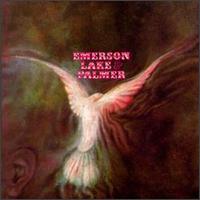 Emerson,
Lake and Palmer (1970), ***
Emerson,
Lake and Palmer (1970), ***
Not as
good as Thoughts of Emerlist Davjack, despite the same score.
With his new partners Emerson had finally found musicians as good as
himself to work with, and the public was thankfully freed from
hearing Lee Jackson's voice. Even so ELP built primarily on
past work; "The Barbarian" sounds like very good
late-period Nice, with Emerson showing off his appreciation of 20th
century composers. Also, "Take a Pebble" is an
attempt to recapture the dramatic sound of Lake's work in King
Crimson, but with a
guitar hoedown, Emerson interludes and an ending straight off of Days
of Future Past. Yet, it is a good song, one of the best on
the album. Yes, ELP are technically gifted, but with the
pretentiousness to go along with it. Some of Lake's lyrics in
"Take a Pebble" are simply bad (I'm thinking of the
overcoat lines), and Palmer overplays when he gets the chance (his
solo in "Tank"). Emerson discovered synths at this
point, abusing Stevie Wonder's cool electric harpsichord
"Superstition" sound for a pedestrian instrumental ("Tank",
which also features annoying tweety synths). Not to mention the
one standout track, Lake's "Lucky Man" -- a classical folk
song followed by Emerson's famous synth line, which gave them their
first hit. The truth is that every track has aspects that are
good and bad (as obvious as that statement is). Produced by
Lake.
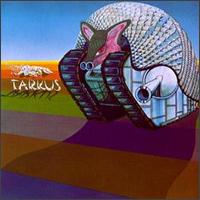 Emerson,
Lake and Palmer: Tarkus (1971), ***1/2
Emerson,
Lake and Palmer: Tarkus (1971), ***1/2
Well, this is
better. The first side is apparently the story of Tarkus,
portrayed on the
slopes of a volcano as the unnatural union of a tank
and an armadillo. Fortunately, the music itself is much easier
to grasp. Emerson stuck mostly with organ, and again chose some
odd synth noises, while Lake improved his lyrics and Palmer did his
semi-obnoxious technical things. The group demonstrates that
they can play in tricky time signatures without being obnoxious
("Eruption"), and the opposite ("Infinite Space"
with its subdivided 7/4 time that screams 'Important Technical
Improvement'). Some of Tarkus is really good, such as
"Stones of Years", a sort of distorted blues song which
begs the question of whether or not Palmer could play a straight
beat. There are some more traditional rock (the anti-war
"Battlefield" with Lake trotting out some good electric
guitar lines), some relatively lighter stuff (the angry "Bitches
Crystal" with Palmer chattering away, and the Winifred Atwell's
Other Piano wild-west saloon number "Jeremy Bender").
Otherwise filler
instrumentals make up most of the first side (Tarkus'
battles I guess), of which the worst is "Aquatarkus" with
its chicken-impersonating-human synth sound and cheesy ending, and on
the second side has some preachy anti-God pro-Man tracks. Oh
yeah, there is also a toss-off 50s rock tribute to their engineer
Eddy
Offord ("Are
You Ready Eddy?") with some dreadful backing vocals. All
together this album is kind of pompous, but at the core there are
some really solid songs. Produced by Lake.
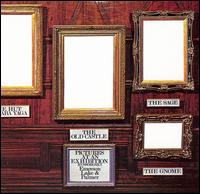 Emerson,
Lake and Palmer: Pictures at an Exhibition (1971), **1/2
Emerson,
Lake and Palmer: Pictures at an Exhibition (1971), **1/2
Classical
composer Mussorgsky wrote the original Pictures at an Exhibition
of course, and it is better than this. This is a live
recording, but it isn't intended to compliment any studio album, as
the songs do not appear elsewhere. In terms of instrumentation,
Emerson relies only on organ and sythns here, and Lake mainly sticks
to excellent sounding bass, only picking up his acoustic guitar once
on the fabulous classical "The Sage" (easily the best track
on here, even if it does echo "Epitaph").
Emerson's synth noises vary from the squealing fun crowd teasers in
"The Old Castle" to downright diarrhetic ("Curse of
Baba Yaga" indeed). Overall, Emerson appears to have been
in charge, despite Lake's spotlight song, and Palmer was content to
be his flawless speedy self. Curiously enough he even used what
sounds like Big Band-style drum beats during "The Old Castle".
The few "group numbers" (where Lake sings and Emerson
plays) are not notable, and they manage to sound like a church
service only once ("The Great Gates of Kiev", which ends
with the appropriate line "Death is Life"). Other
than that, "Promenade" manages to wear out its welcome by
the ninth listen, and it is rather amusing to hear a good blues jam
when only two
years earlier Emerson
used a back cover to explain why the Nice did not play blues.
Produced by the group.
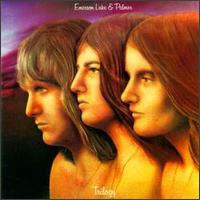 Emerson,
Lake and Palmer: Trilogy (1972), ****
Emerson,
Lake and Palmer: Trilogy (1972), ****
This is
probably ELP's strongest work, and certainly their most accessible,
as Emerson did not overuse synthesizers or technical instrumentals.
In fact, Trilogy seems to be a crystallization of their
previous albums, as all the album follow the same pattern, more or
less. The album's introduction is well designed to grab the
audience's attention --quiet questioning synth noises answered by
percussion and piano snippets, before breaking into their best hymn
number ("The Endless Enigma [Part One]"). In fact,
Emerson's keyboard runs and Lake's superb singing helped convince me
not to turn the album off when I first listened to it, as this was my
first ELP album. The second part of "The Endless Enigma"
is not quite as good, mainly because Emerson adds synthesized horns
and repeating bell loop, making the track sound like some overblown
Christmas song, but a very nice Romantic piano number is in
between ("Fugue" although let's remember that
this
idea had been done before),
with simple touches like only a triangle for percussion. The
title track starts out in a similar way, smoothly lamenting before
the synths come in again and things take a turn for the unexpected.
To wit, the song's latter part is done in a Caribbean style, with
Emerson even making his synths sound like steel drums. That was
certainly unexpected, and they get points for trying.
Otherwise, many tracks do not really break new ground, but are better
than earlier, similar songs. For starters, there is Lake's
excellent acoustic "From the Beginning", which features
some great bass/guitar interplay and is my favorite ELP song.
"The Sheriff" is a fun organ number, and Lake
almost growls out his vocals over Emerson's fierce organ riff on
"Living Sin". The only real time-eaters are the
obligatory classical covers; this time they are Aaron Copeland's
"Hoedown" and a bolero (not strictly a cover, but almost as
boring and tepid as the more famous one). Yes, Palmer does his
usual good job at coming up with interesting drumming. Produced
by Lake.
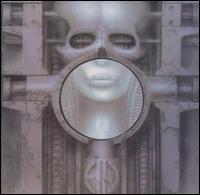 Emerson,
Lake and Palmer: Brain Salad Surgery (1973), **1/2
Emerson,
Lake and Palmer: Brain Salad Surgery (1973), **1/2
Now this is a
mixed bag. Whereas Trilogy consisted mostly of
highly-technical popular music, Brain Salad Surgery is ELP at
its most symphonic to date. After the now familiar convocation
(a rendition of "Jerusalem" which is perhaps their best
along these lines, and the group's lone single), the album moves to
an arrangement of a movement from one of Ginastera's
piano concertos ("Toccata"). At various
points this has the sound of background music to a fairly cheesy
science fiction program, with Palmer banging away on timpani and
other tuned percussion in a fairly pointless solo, and a synth
section that sounds like a computer alarm going off until Palmer
comes in and it turns into a frightenly modern techno section!
One has to wonder what the original sounds like. There are some
unimportant perennials (the low point of the album being Lake's fake
Cockney accent for "Benny the Bouncer"), and the four-part
suite "Karn Evil Nine". Perhaps the suite's
overarching theme is in the liner notes; I wouldn't know as my record
didn't come with any. It does manage to last for about two
thirds of the album, with enough rhythm changes and soloing to make
most musicians blush. Its most surprising aspects are Lake's
carnival barker persona, the amount of electric guitar he was allowed
to play ("1st Impression"), and Emerson's return to a steel
drum synth sound in the second movement. Plenty of
Gershwin-influenced piano, fake horn synth lines, "computerized"
voices and more to keep everyone sporadically entertained. The
concluding part, featuring lyrics by former King
Crimson member
Pete Sinfield, is fairly anti-climactic, with what sounds like a
space battle taking place in the middle, and then drifting off into
what has to be one the odder endings to an album: an increasingly
sped up synth line. The problem with all of this is that there
no real clear cut "good" movement of the suite; simply a
lot of ideas that work or do not, in close proximity to each other.
At least Sinfield's lyrics are better than Lake's.
Frustrating. Produced by Lake.
Emerson, Lake and Palmer: Welcome
Back My Friends to the Show that Never Ends (1974)
A
triple live set. Have to keep up with the Joneses you know.
And the Andersons,
Howes, Squires, etc...
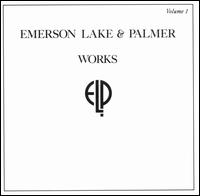 Emerson,
Lake and Palmer: Works, Vol. 1 (1977), **
(split Rating - see below)
Emerson,
Lake and Palmer: Works, Vol. 1 (1977), **
(split Rating - see below)
This
should rightfully be credited to Emerson, Lake, Palmer, and (EL&P)
as the three decided that anything branded with ELP at this point
(four years after their last studio album, four years!) would
sell better than individual solo albums. Artistic integrity (or
lack of it) issues aside, Works Vol. 1 is three sides solo,
one side group. Emerson devotes his side to his fully
orchestrated "Piano Concerto No. 1" (what, no Opus
number?), a genre exercise whose excitement does not last much beyond
the first movement. At least he sticks to a Steinway.
Lake takes on a pile of semi-schlocky Sinfield songs (of which "C'est
La Vie" is the least worrisome), but abandons his trademark
classical acoustic approach. Instead, he opts for poor
overproduction, in what could be described as an attempt to mold
himself into an adult contemporary artist (did these exist back
then?). His guitar is diminished to a tinny noise in the back
amongst his session band, various orchestrations and choirs, while
his vocals take center stage. His voice also sounds like it may
be on the wane --it is lower, and he's starting to scoop up to high
notes ("Lend Your Love To Me Tonight"). But the
album's most stunning side belongs to Carl Palmer, who gets his own
(musical) voice for the first time. Almost every track has a
different approach - be it a percussion arrangement of Bach, a
strange sax led fusion jam/50s boogie that includes Emerson and Joe
Walsh ("LA
Nights"), funky rhythms and talk boxes that sound like a Jeff
Beck track minus
Beck ("New Orleans"), or a mixture of extinct White Horn
Rock with Canterbury style organ ("Food For Your Soul" -
easily the album's best track). He even manages to lay "Tank"
to rest with some dignity. The group side, as one might expect,
is less than stellar. "Fanfare for the Common Man"
sounds remarkably like Nice-plus-synths (read: Emerson over
dispassionate backing), while "Pirates" is actually one of
their most ambitious works. Sinfield's libretto gets
transformed into a cross between a short operetta and a production of
Grease, with an orchestra in support. Lake sounds like
the sole singer on a stage, but despite an interesting opening
(Emerson's wub-bub-bubing synths sound like the background to Dr.
Who Meets Frankenstein) the music's eventual devolution into
sock-hop territory seems out of place. It isn't a not a
disaster, but assuredly not a success. All in all, there's
maybe half of a good album in here. Ratings Breakdown:
(Emerson, ** +
Lake, ** + Palmer,
***1/2 + ELP, *1/2
= **)
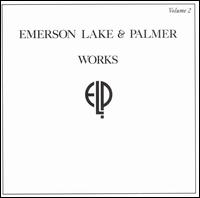 Emerson,
Lake and Palmer: Works, Vol. 2 (1977), ***
Emerson,
Lake and Palmer: Works, Vol. 2 (1977), ***
Released one
month after Vol. 1, Vol. 2 contains
whatever did not make it onto the fiest album, and what was
lying around in the vaults. It is surprising then that this
material is much stronger that what appeared on Vol. 1 .
While Emerson donates a trio of pre-war piano numbers that define
"pleasant genre-based filler," Lake's contribution (the
Sinfield ballad "Watching Over You") blows away his
previous solo tracks with its uncluttered production (the guitar
sounds normal too). One of Palmer's tracks is even more complex
and bizarre than his Vol. 1 material ("Bullfrog"),
and a whole load of fun too. As for group songs, there's a pair
of lukewarm Sinfield numbers (the derivative "Tiger in a
Spotlight" and the marginally better "So Far to Fall")
and a cover of the old jazz tune "Show Me the Way to Go Home"
which is a perfect ending to the album. As for the older
tracks, "Brain Salad Surgery" shows why it got cut from its
own album, and Lake's huge solo hit "I Believe in Father
Christmas" is an anti holiday nightmare - Lake borrows from
Billy Nicholls while Emerson quotes Prokofiev repeatedly. Only
a ludicrously entitled jam that was ELP's only B-side deserves the
airing that it gets here ("When the Apple Blossoms Bloom in the
Windmills of Your Mind I'll Be Your Valentine").
Ironically, in general this is of much higher quality than Works,
Vol. 1.
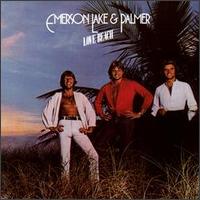 Emerson,
Lake and Palmer: Love Beach (1978), ***
Emerson,
Lake and Palmer: Love Beach (1978), ***
As if one
needed any
more proof that
prog-rock was losing its audience, ELP began to revert back into a
mainstream pop-rock band. The first half of this album is what
the title suggests - a series of Lake/Sinfield songs that are an
additional step in transforming Lake into a sex-em-up pop singer.
The catch is that on the whole they are a lot better than the drivel
on Works Vol. 1 ("All I Want Is You" and the title
track), and ELP sounds like a "regular" band with Lake
doubling on guitar and both Emerson and Palmer playing (the latter's
drumming on "The Gambler" is a benefit of playing with
your own band-mates, for one). Granted, there is one large
misstep ("Taste of My Love" which appears to be an exercise
in cramming bad euphemisms for sex into a song), but at least Emerson
avoids any really annoying synth noises, opting instead for a Bosun's
Whistle Lite™ sound. The second half shows the other side
of Sinfield's coin - a series of songs entitled "Memoirs of an
Officer and a Gentlemen" which is both classy and memorable.
Emerson, who co-wrote, sticks mainly to romantic piano, or even
electric piano (which I think is something new for him at
least) and as a result the sound harkens back to the days of Trilogy,
or even "Take a Pebble". It's well played, full of
memorable hooks and actually compelling to listen to, as opposed to
the bloated monsters on Works Vol. 1. A fitting farewell
for the group, or at least until the reformed in early 1990s.
I'm going back
...to the Music page that is...
 The
Nice: The Thoughts of Emerlist Davjack (1967), ***
The
Nice: The Thoughts of Emerlist Davjack (1967), ***
 The
Nice: Ars Longa Vita Brevis (1968), **1/2
The
Nice: Ars Longa Vita Brevis (1968), **1/2
 The
Nice: Nice (1969), **
The
Nice: Nice (1969), **
 The
Nice: Five Bridges (1970), **
The
Nice: Five Bridges (1970), **
 The
Nice: Elegy (1971)
The
Nice: Elegy (1971)  Refugee
(1974), **1/2
Refugee
(1974), **1/2  Emerson,
Lake and Palmer (1970), ***
Emerson,
Lake and Palmer (1970), ***
 Emerson,
Lake and Palmer: Tarkus (1971), ***1/2
Emerson,
Lake and Palmer: Tarkus (1971), ***1/2
 Emerson,
Lake and Palmer: Pictures at an Exhibition (1971), **1/2
Emerson,
Lake and Palmer: Pictures at an Exhibition (1971), **1/2
 Emerson,
Lake and Palmer: Trilogy (1972), ****
Emerson,
Lake and Palmer: Trilogy (1972), ****
 Emerson,
Lake and Palmer: Brain Salad Surgery (1973), **1/2
Emerson,
Lake and Palmer: Brain Salad Surgery (1973), **1/2
 Emerson,
Lake and Palmer: Works, Vol. 1 (1977), **
(split Rating - see below)
Emerson,
Lake and Palmer: Works, Vol. 1 (1977), **
(split Rating - see below)  Emerson,
Lake and Palmer: Works, Vol. 2 (1977), ***
Emerson,
Lake and Palmer: Works, Vol. 2 (1977), ***
 Emerson,
Lake and Palmer: Love Beach (1978), ***
Emerson,
Lake and Palmer: Love Beach (1978), ***